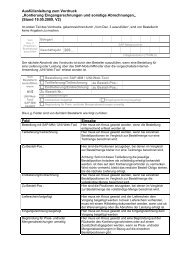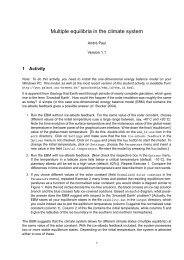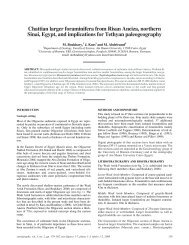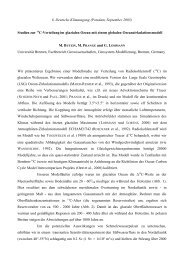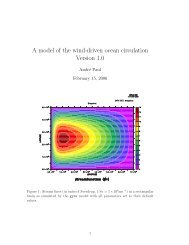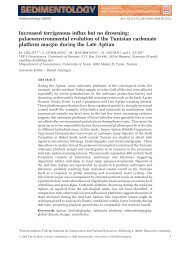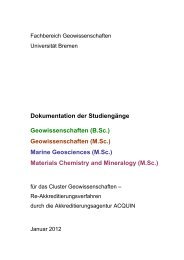Forschung im HLRN-Verbund 2011
Forschung im HLRN-Verbund 2011
Forschung im HLRN-Verbund 2011
- Keine Tags gefunden...
Erfolgreiche ePaper selbst erstellen
Machen Sie aus Ihren PDF Publikationen ein blätterbares Flipbook mit unserer einzigartigen Google optimierten e-Paper Software.
164Fundamental Constants of Quantum Chromo Dynamics:a multiscale problem.Precision charm physics with N f = 2 dynamical quarksR. Sommer, U. Wolff, NIC, DESY; Humboldt-Universität zu Berlin, Institut für PhysikAbstract• The Standard Model is our theory of subatomicphysics, validated down to very small distances.It comprises Quantum Chromo Dynamics (QCD)describing the strong interaction.• Some of the fundamental constants of Natureare associated with QCD: the strong couplingconstant α s and the masses of the quarks,m u , . . .,m t , indicated in the Figure.• We s<strong>im</strong>ulate QCD using a finite size techniqueto cover the multiple scales of the theory andrelate its fundamental constants to exper<strong>im</strong>entalobservables, such as the mass of the proton.• Our project is part of the international ALPHAcollaboration programme and the data sets arecoordinated within the CLS consortium [1].Over the last few decades, particle physicists haveexplored the fundamental forces down to distancescales of ≈ 10 −18 m. It was found that the exper<strong>im</strong>entalobservations are described to very high accuracyby a theory which is known as the StandardModel of particle physics.The Standard Model describes the interactionsof the fundamental constituents of matter throughelectromagnetic, weak and strong forces in termsof three different quantum gauge theories. It doesso very accurately and in terms of very few fundamentalconstants of Nature. Apart from the mathematicals<strong>im</strong>plicity of its basic equations it was essentialfor the success of the Standard Model thatthe forces involved are mostly relatively weak atthe typical energy transfers in particle physics scatteringexper<strong>im</strong>ents of about 10 − 100 GeV. 2 Thestrengths of the interactions are characterized byso-called coupling constants. When the forces areweak, the predictions of the theory can be workedout in terms of an expansion in powers of thesecoupling constants, a procedure known as perturbationtheory. For instance, in Quantum Electrodynamics(QED), the quantum gauge theory describingthe interactions between electrons and photons,the coupling constant is the well-known finestructure constant α ≈ 1/137. Its smallness guaranteesthat only a few terms in a power series aresufficient in order to predict physical quantities withhigh precision.The gauge theory for the strong force is QCD,where quarks and gluons assume the rôles of theelectrons and photons of QED. Quarks are the constituentsof the more familiar proton and neutron.The coupling constant of QCD, α s , then characterizesthe strength of the interaction between quarksand gluons. One <strong>im</strong>portant property of all coupling“constants” in the Standard Model is that they dependon the energy transfer µ in the interaction process.In this sense they are not really constant,and one usually refers to them as couplings that“run” with the energy scale. At µ ≈ 100 GeV thestrong coupling constant has been determined asα s ≈ 0.12. Although this is much larger than thefine structure constant of QED, perturbation theorystill works well. However, if the energy scale µ isdecreased from 100 GeV the value of α s increases.In fact, at µ ≈ 1 GeV it becomes so large that perturbationtheory cannot be relied upon any more.It is then obvious that particle theorists require atool which is able to deal with large values of α s . Anon-perturbative method is needed to work out thepredictions of QCD in this situation.The s<strong>im</strong>ple and elegant theory of QCD is formulatedin terms of quarks and gluons. Yet whatis observed in exper<strong>im</strong>ents at low energies, say,µ < ∼1 GeV are protons, neutrons, π-mesons andmany other particles, all known as hadrons. In fact,a striking property of QCD is “confinement”, whichmeans that quarks and gluons cannot be producedin exper<strong>im</strong>ents.Computer s<strong>im</strong>ulations of QCD formulated on adiscrete lattice of space-t<strong>im</strong>e points allow for a nonperturbativetreatment of the theory in the lowenergyreg<strong>im</strong>e. As usual when compute gridscome into play, one must extrapolate the answersto the continuum l<strong>im</strong>it by studying sequences ofprogressively finer discretizations. In addition computersdemand the enclosure of space-t<strong>im</strong>e into afinite region which is an approx<strong>im</strong>ation that has tobe controlled. In such s<strong>im</strong>ulations it is natural touse a few hadron masses as input to tune the freeparameters in lattice QCD and to then predict therest.To establish a unified description for all energieswe need to relate the input parameters of perturbativeQCD and of lattice QCD to each other.2 In particle physics it is customary to use “natural units” where the speed of light c and Planck’s constant ¯h are set to one, andenergies as well as masses are given in GeV. As an orientation note that m proton ≈ 1GeV, where 1GeV = 1.602 · 10 −7 J.Physik



